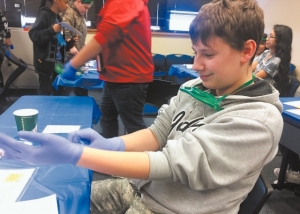Spring Creek Middle students seek answers using forensics
By Joey Pitchford
Published in News on March 7, 2018 5:50 AM

News-Argus/JOEY PITCHFORD
Jacob Hildebrand pulls on gloves before starting a blood test experiment during the Bionetwork EASE program Friday. Hildebrand said this experiment was his favorite of the four he did throughout the day.
Over the years, famous mysteries have perplexed scientists and explorers, who have come up empty in attempts to find the truth. Who was Jack the Ripper? How did Amelia Earhart disappear?
And now, for 130 Spring Creek Middle School students, a new question -- what happened to Chelsea?
The students took part in a forensic-themed program led by Bionetwork at Wayne Community College Friday, where they used various scientific methods to determine the fate of Chelsea, a camerawoman for a fictional television show.
Erin Bingham, director of programming for Bionetwork, explained the story behind the activities the students were completing.
"We have the Hawthorne Mansion is western Carolina. The crew from the fictional TV show Spirit Tracker goes there in order to record the paranormal," she said, suspense in her voice. "While they're there, their camerawoman goes missing."
In a video the students watched earlier in the day, they saw some of Chelsea's interactions with her coworkers, as well as some potential strange occurrences within the house. From there, they set out testing evidence through a variety of techniques, including chemical analysis of a mysterious white powder, using electrophoresis to identify a specific strand of black fiber and using antibodies to identify the blood type of blood found at Chelsea's last known location.
Jacob Hildebrand, an eighth-grade student at Spring Creek, had just finished the blood testing experiment.
"That one was my favorite," he said. "I don't really know why, I just liked it."
Bionetwork, which put the event on, is part of the North Carolina Community College System. Bingham said that the group is an initiative to support the life science industry, while also bringing students to their local community colleges to make sure they are aware of everything available to them there. The forensic event in particular was part of the EASE program, which stands for Effective Authentic Science Events, Bingham said.
"This is programming that is targeted at middle schoolers," she said. "Research has found that typically it is in middle school that students lose their interest in [science, technology, engineering and mathematics], so we want to give them a positive experience with science."
Several WCC faculty and staff members joined in to help with the program, volunteering even though they were on spring break.
